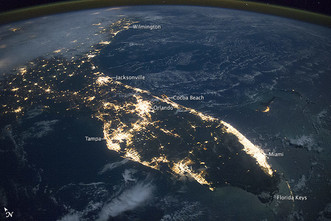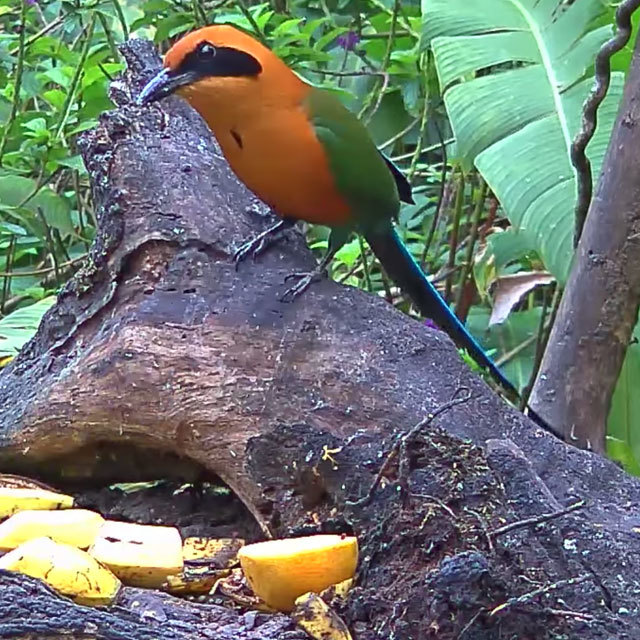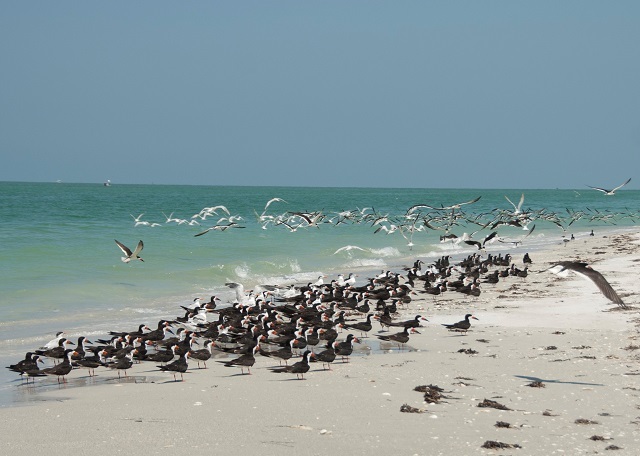 City lights can be a hazard for migrating birds (NASA photo).
Spring and fall are exciting times for birders in the Atlantic flyway. It is time to say hello or goodbye to a host of neotropical migrants - musical warblers, regal Swallow-tailed Kites, and shorebirds on our beautiful beaches.
It’s not easy to be a migrating bird – traveling across continents is a grueling endeavor, and the expansion of urban development means there are fewer places to rest and refuel. One other major problem for migrating songbirds is light pollution. These birds often travel by night and can become confused when flying over brightly lit cities and suburbs. Exhausted after trying to navigate around these light sources, birds can easily succumb to other dangers including window strikes.
Audubon has developed the Lights Out program to help combat this important issue. With the resources and support provided by the program, local Audubon chapters can encourage homeowners and building managers to turn down the brightness. Here in Florida, Duval Audubon Society, St. Johns County Audubon Society, the Jacksonville Zoo and Gardens, and Downtown Vision Inc. have partnered to create the Lights Out Northeast Florida initiative.
In addition to raising awareness, volunteers for Lights Out Northeast Florida regularly monitor areas in downtown Jacksonville, looking for birds that have been killed or injured. After collecting this data, the team will be able to identify the most dangerous locations and dates, which will allow them to make effective recommendations to protect migrating birds.
If you are in the Jacksonville area and interested in helping with the effort, you can fill out a volunteer application online. If you aren’t a resident of northeast Florida, you can also easily adapt Audubon’s sample letters to elected officials or building managers in your region to bring their attention to the issue.
You can also help in the fight against light pollution at home with just a few simple steps:
- Turn off unnecessary exterior light, especially during the period of 11 p.m. to 5 a.m.
- Direct lights to point downward or install shields to block upward light.
- Install automatic motion sensors instead of leaving floodlights on all night.
- Turn off interior lights when feasible, especially on higher floors of tall buildings.
Just these few small changes can make a huge difference to migratory birds!
 Wildlife cameras like the Cornell Lab of Ornithology's Panama fruit feeder cam can show you wildlife from around the world, like this colorful Rufous Motmot.
It’s July in Florida – it’s hot, it’s muggy, it’s buggy. While there’s still plenty of fun to be had adventuring outside, on some days just the thought of going for a walk can make us feel sweaty.
Fortunately, there’s a way to watch wildlife from Florida and around the world in the comfort of our air-conditioned homes. Many organizations have set up webcams spotlighting everything from nesting birds to underwater wonders. These are some of our favorite streams for a glimpse into the outdoors.
Arizona Bat Cam – Several species of bats can be seen roosting in a barn at the Cluff Ranch Wildlife Area.
Manatee Cam – Peek into the crystal blue waters at Ellie Schiller Homosassa Springs State Park. It’s the off season for manatees right now but there is still plenty to be seen at this Great Florida Birding and Wildlife Trail site!
Panama Fruit Feeders – Take a virtual tropical vacation to see colorful hummingbirds, tanagers, motmots and more.
St. Augustine Alligator Farm – This camera highlights Roseate Spoonbills, Wood Storks, herons, egrets and plenty of gators at the farm’s rookery.
Brooks Falls Bearcam – July is one of the best months to watch bears fish for salmon at Katmai National Park and Preserve in Alaska. Up to 25 bears have been seen here at once!
Chesapeake Conservancy Osprey Cam – A pair of Ospreys, lovingly named Tom and Audrey, have been using a nest on the eastern shore of Maryland since 2009.
For even more virtual wildlife viewing, visit Explore.org/livecams for over 100 streams full of fascinating animals.
 A flock of Black Skimmers congregates on the coast at Cayo Costa State Park (FWC Photo).
Nearest City: Boca Grande
Four nautical miles off the coastline of Pine Island, 33921
Open: Daily, 8 a.m. to sunset
Website
A trip to this barrier island park is a unique experience. Board one of the commercial ferries that service the park and expect a day of birding in relatively undisturbed tranquility. Look for species including American Oystercatcher, Black Skimmer, Snowy Plover and Least Tern. Magnificent Frigatebirds, Ospreys and Bald Eagles ply the open air above. Mangrove swamps and interior scrub and hammock are also on the island, so watch for hawks and owls as well as smaller birds, such as buntings (Indigo and Painted) and warblers during spring migration. Take everything you might need for an entire day trip (there are no stores on the island) or make arrangements to spend the night in the campground if you wish to enjoy a beautiful night sky and to see what is moving at first light.
|